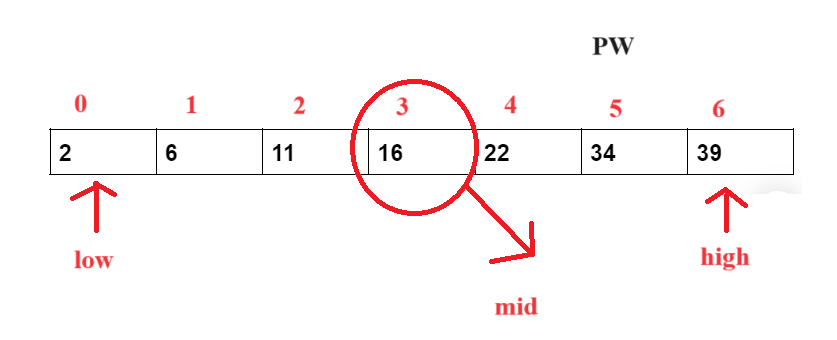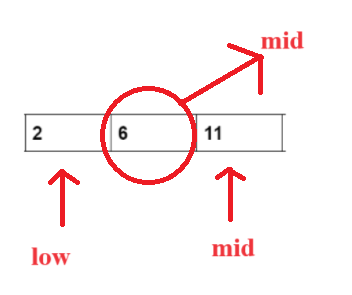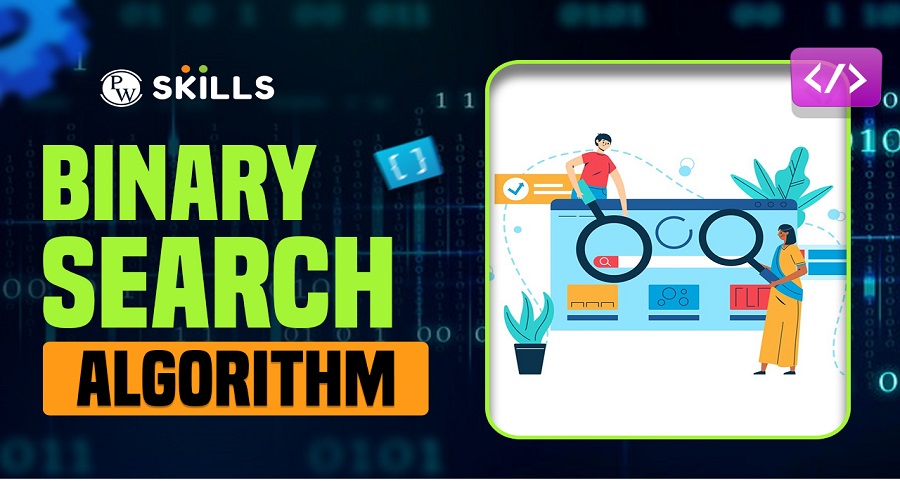A Binary Search Algorithm is an efficient algorithm for finding an item from a sorted list of items. The algorithm works by repeatedly dividing the list into half portions, which can contain the item to be searched until we narrow down the possible location to just one. In the end, if the element is present in the list, its index is returned. In this article, we will learn about the Binary search algorithm.
What is a Binary Search Algorithm?
The Binary Search Algorithm is an efficient searching algorithm that uses the divide and conquer method to search for an element in a sorted array or list. It is one of the most popular searching algorithms. It is more efficient than linear search algorithms.
Under this algorithm, we compare the target value with the middle element and decide which half will most probably contain the target value. The algorithm then shifts to that part of the list. It keeps on dividing itself until the start and end pointers coincide. The time complexity of the binary search algorithm is in logarithmic time, O(logn), where n is the number of elements in the array. It works faster than a linear searching algorithm, as here, we do not have to traverse the whole array.
Also Read: Python vs Java: Which is Best for Machine learning algorithm
Important Points For Binary Search Algorithm
Some major important highlights of the binary search algorithm must be kept in mind.
- The Binary search algorithm works only on a sorted array or list.
- It works on a divide-and-conquer approach.
- The time complexity of the binary search algorithm is logarithmic.
- Binary search is faster and more efficient than linear search algorithm.
- It is efficient for large datasets.
Binary Search Algorithm
The algorithm for binary search is given in the table below.
| Binary Search Algorithm |
| binary_Search( a, lower_bound, upper_bound, target)
Step 1: set start = lower_bound, end = upper_bound, pos = – 1 Step 2: repeat steps 3 and 4 while start <=end Step 3: set mid = (start + end)/2 or start+(end-start)/2 Step 4: if a[mid] = target set pos = mid print pos go to step 6 else if a[mid] > target set end = mid – 1 else set start = mid + 1 [end of if] [end of loop] Step 5: if pos = -1 print “Not Present” [end of if] Step 6: exit |
Working on Binary Search Algorithm
The binary search algorithm is a searching algorithm that works on the divide and conquer principle. It searches the target element in a sorted array.
Consider a sorted array, arr[ ]= { 2,6,11,16,22,34,39}. Now, let us search for an element X= 2. We will use a binary search algorithm to find the index of the element in the array.
- Step 1: First we need to calculate the mid value of the array by using the formula given below.
mid = (low+high)/2
- Step 2: At the beginning, keep low = 0 and high = size-1.
- Step 3: Now, let us calculate the value of mid. Hence, the element at index 3 is the mid-value.
mid = (0+6)/2 = 3.

- Step 4: Now, we will check whether the target element is greater or less than the arr[mid]. Here, our target element is lesser than the arr[mid], i,e. 2<16. Hence, now we will take our high value to mid-1.
high = mid-1
- Now, our array will reduce to the following. Now calculate the mid value again.
mid= (0+2)/2=1

- Now, we again check whether the target element is greater than or less than the arr [mid], i.e., 2<6. Hence, we again reduce the size of our array and take high to mid-1.
- Now, our low and high both point to the same index. Now, calculate the mid value. We find that the arr[mid]== X, i.e., 2==2. Now, we will return the index of the element.

- If the element is not present in the array, then the low and high will cross each other then return -1.
Also Read: Full Form of OOPS
Time and Space Complexity of Binary Search Algorithm
The binary search algorithm works in logarithmic time complexity with constant space. Check the binary search algorithm’s best, average and worst time complexity below.
| Time Complexity of Binary Search Algorithm | |
| Case | Time Complexity |
| Best Case | O(1) |
| Average Case | O(logN) |
| Worst Case | O(logN) |
- The best-case complexity happens when our target element is found in the first iteration, i,e. It is the first middle element. The best time complexity of the binary search algorithm is O(1).
- The average time complexity of the binary search algorithm is O(logn).
- The worst time complexity occurs when our target element is the last. We keep dividing until the last element is left, our target element. The worst time complexity of the binary search algorithm is O(logn).
The space complexity of the binary search algorithm is O(1). It requires a constant space, and no additional space is required for this algorithm.
| Space Complexity of Binary Search Algorithm |
| O(1) |
Difference Between Linear Search Algorithm and Binary Search Algorithm
The two most popular search algorithms are linear and binary search algorithms. Let us highlight some of their major differences below.
| Difference Between Linear Search and Binary Search Algorithm | |
| The Linear Search algorithm works by traversing the complete list one by one to search the target element. | The Binary Search Algorithm is an efficient algorithm for finding an item from a sorted list of items |
| It does not require the list element to be sorted. | It requires the elements to be in sorted order. |
| The time complexity of the linear search algorithm is O(N), where N is the number of elements in the array. | The time complexity of a binary search algorithm is O(logN), where N is the number of elements in the list. |
| It only works with the divide-and-conquer approach. | It works on the divide and conquer approach. |
| It is simple but inefficient for large datasets. | It is suitable for large datasets. |
Implementation of Binary Searching Algorithm In C++
Check the C++ code for implementing the binary search algorithm.
| Binary Search Algorithm using C++ |
|
Implementing Binary Search Algorithm With Java
Check the Java code to implement the binary search algorithm in the table below.
| Binary Search Algorithm Using Java |
class BinarySearch {
/* if the item to be searched is present in the middle */
/* if the item to be searched is smaller than the middle, then it can only
/* if the item to be searched is greater than middle, then it can only be
|
Binary Search Algorithm FAQs
What is a binary search algorithm?
The Binary Search Algorithm is an efficient algorithm for finding an item from a sorted list of items. The algorithm works by repeatedly dividing the list into half portions, which can contain the item to be searched until we narrow down the possible location to just one.
Is binary search the most efficient algorithm?
Yes, a binary search algorithm is a more efficient algorithm than a linear search algorithm. It is considered one of the best search algorithms as it works on the divide-and-conquer approach.
Why is it called binary search?
The binary search algorithm works by dividing the complete array into more than one halves and then shifting the array to the probable part where we can find our target element. Hence, it is called binary search algorithm.
What are the four steps of a binary search algorithm?
The complete four steps of the binary search algorithm are:
Set the search space by setting up the starting and end pointer. The start pointer points to the first index, and the endpoints to the last index.
Now calculate the mid-element.
Shift the pointers to the favourable part of the array.
If an element is found, return the index. If not found, return -1.





